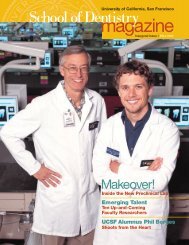Acknowledgements - UCSF School of Dentistry - University of ...
Acknowledgements - UCSF School of Dentistry - University of ...
Acknowledgements - UCSF School of Dentistry - University of ...
You also want an ePaper? Increase the reach of your titles
YUMPU automatically turns print PDFs into web optimized ePapers that Google loves.
Conclusion: While both proactive and passive phone education formats were acceptable to parents, the proactive format reached<br />
a higher proportion <strong>of</strong> the sample population, particularly Spanish-speakers. This pilot study suggests proactive phone education<br />
with oral health information might be <strong>of</strong> interest to low-income Spanish speaking parents <strong>of</strong> young children.<br />
Support: USDHHS/NIH/NIDCR U54DE019285<br />
#31 Title: Tobacco-Use Screening and Treatment in the <strong>UCSF</strong> <strong>School</strong> <strong>of</strong> <strong>Dentistry</strong>: A Pilot Study<br />
K JARVI (1), D PIVNIK (2), T CHAI (3), K MEISELS (3), P CURL (4), L KROON L (5), J PROCHASKA (4), M WALSH (6)<br />
(1) <strong>UCSF</strong> MS Graduate Program in Dental Hygiene Graduate Division Dental Hygiene (2) <strong>UCSF</strong> <strong>School</strong> <strong>of</strong> <strong>Dentistry</strong>, (3) <strong>UCSF</strong> <strong>School</strong> <strong>of</strong><br />
Pharmacy, (4) <strong>School</strong> <strong>of</strong> Medicine, (5) Vice Chair <strong>School</strong> <strong>of</strong> Pharmacy, (6) <strong>UCSF</strong> Department <strong>of</strong> Preventive and Restorative Dental<br />
Sciences<br />
Introduction: The leading cause <strong>of</strong> preventable death in the US, tobacco accounts for nearly 1 in 5 deaths or 443,000 annually (1). US<br />
Clinical Practice Guidelines recommend clinicians assess tobacco use with all patients at all visits and provide evidence-based cessation<br />
treatments.<br />
Objective: To determine clinician tobacco-related screening and cessation practices at the <strong>UCSF</strong> Medical Center Outpatient clinics<br />
Methods: A three-pronged cross-sectional assessment was conducted with a convenience sample <strong>of</strong> (1) clinic directors or their designee,<br />
(2) clinicians, and (3) patients at <strong>UCSF</strong> outpatient medical and dental clinics.<br />
Results: Assessments were completed with 11 <strong>of</strong> 15 dental clinic directors, 100 dental providers, and 100 <strong>of</strong> 110 approached dental<br />
patients and with 12 out <strong>of</strong> 27 medical administrators, 36 medical providers, and 120 <strong>of</strong> 122 approached medical patients. Overall, 47% <strong>of</strong><br />
patients reported they were asked about tobacco use. Most clinicians reported they routinely ask about tobacco use (92%), while fewer<br />
reported routinely advising users to quit (82%), assessing readiness to quit (57%), and assisting patients for tobacco cessation treatment<br />
(54%). Less than half <strong>of</strong> the providers reported referral <strong>of</strong> patients to the California quitline. Few clinicians (2%) were aware <strong>of</strong> the <strong>UCSF</strong><br />
Tobacco Education Center (TEC) as a referral resource for cessation treatment. Top recommendations to increase clinical attention to<br />
tobacco use were (1) prompts in the electronic medical record, (2) provision <strong>of</strong> revenue value unit incentives, and (3) greater publicizing <strong>of</strong><br />
referral resources like TEC.<br />
Conclusion: <strong>UCSF</strong> medical and dental providers are performing above the national average for asking, advising, and assessing patients’<br />
readiness to quit smoking, but practice shortcomings were found regarding providing cessation assistance and follow-up. Specific targets<br />
for intervention are identified.<br />
#32 Title: Epithelium-driven G protein signaling regulates the mineralization <strong>of</strong> mandibles<br />
M H LE (1), J A HORST (2), E HSIAO (3), O KLEIN (2), P K DEN BESTEN (2), O V HORST (1)<br />
(1) <strong>UCSF</strong> Department <strong>of</strong> Preventive and Restorative Dental Sciences, (2) <strong>UCSF</strong> Department <strong>of</strong> Or<strong>of</strong>acial Sciences, (3) <strong>UCSF</strong><br />
Department <strong>of</strong> Medicine<br />
Background: G protein-coupled receptors (GPCRs) regulate many cellular activities related to development and differentiation.<br />
However little is known about the influences <strong>of</strong> GPCRs on epithelial-mesenchymal interactions required for normal tooth and jaw<br />
development. Many GPCRs signal through Gs proteins, which activate the production <strong>of</strong> second messenger cAMP.<br />
Objective: Determine the effects <strong>of</strong> increasing Gs signals in epithelia on the formation <strong>of</strong> mesenchymal and epithelial tissues in<br />
murine mandibles.<br />
Methods: We used an engineered Gs-coupled GPCR known as receptor activated solely by synthetic ligands (RASSL) Rs1 to<br />
investigate Gs protein activity in vivo with minimal interference from endogenous ligands. Double transgenic mice expressing Rs1 in<br />
epithelial cells were created by mating K5-tTA mice with TetO-Rs1 mice. Mandibles were harvested six weeks after birth, scanned<br />
using Micro X-ray Computed Tomography (MicroXCT), and examined histologically. MicroXCT scans were analyzed for relative<br />
differences in mineral content using semi-automated algorithms to quantify volumetric pixel intensities <strong>of</strong> bone, dentin, and enamel.<br />
Results: MicroXCT analyses <strong>of</strong> 6-week-old transgenic mice showed a significant decrease (p




